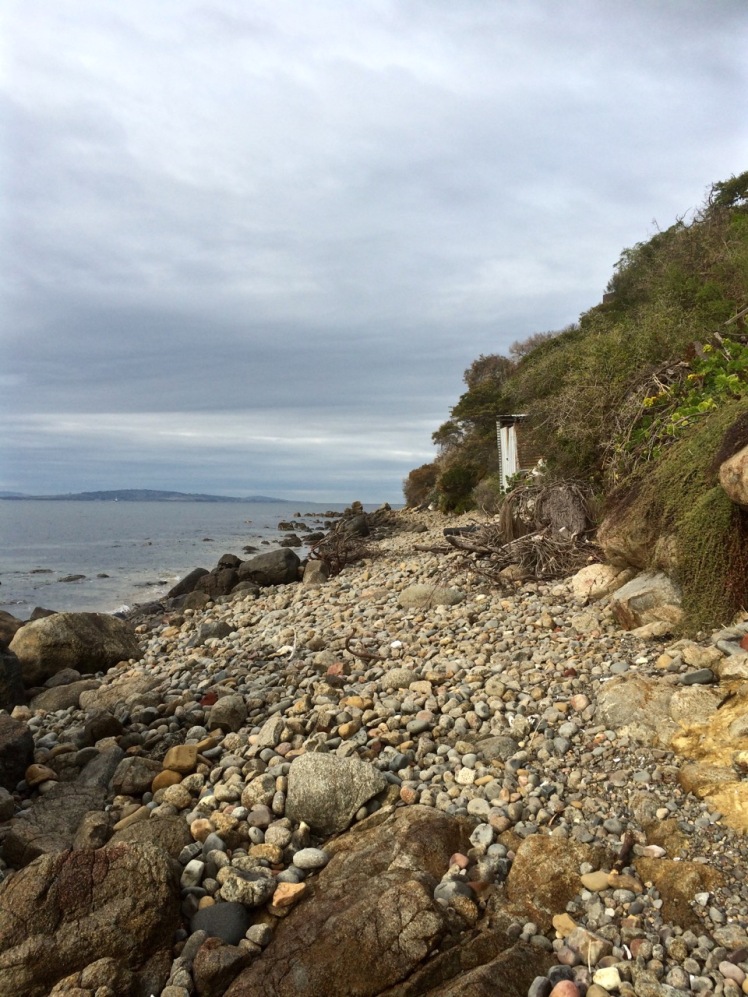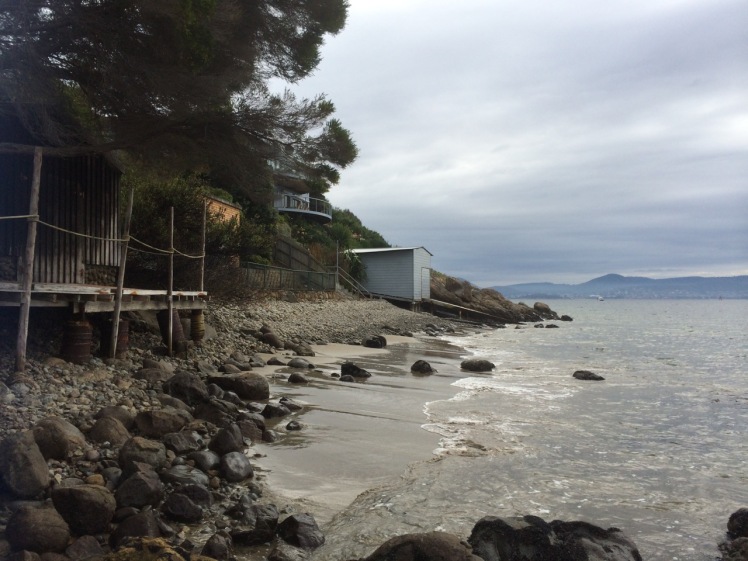Derwent River: Blinking Billy to Hinsby Beach – Part 3: To Mitah Crescent Cove
I Know You, Boulder
The walk continued…
At the end of the beach I had to hop onto rocks and make my way between the river and a concrete wall. Around the corner a wooden boatshed looked as though it might end my walk but I found a way around it and although my walk felt seamless this is where I regard the Blinking Billy Beach 3 section as beginning. Just look at this picture. Who’d think there was a city here?

The same subjects preoccupied me as I walked along – the geology, the history, the structures – and, specifically, locating myself on this piece of shoreline. I kept changing my mind as to where I was in relation to the road above me but I wanted to do this walk without the help of Google Maps so that I had a real sense of (urban) adventuring into the unknown.

In wild weather this would be a windswept stretch of rocky coastline with views north to town, south into Storm Bay and across the river to more loveliness along the southern section of the eastern shore. On the day of my walk these lonely stretches felt pensive, secret and self-contained, and I felt myself more likely to encounter a nineteenth century smuggler along here than back at Red Chapel Beach or Blinking Billy Point. At the same time I felt as though the shoreline was as aware of me as I was of it.
I figured I was out of Geography Bay and this new perspective of the river renewed my feeling of exhilaration in the landscape and perplexity about ourselves – that we Westerners have been here since the beginning of the 1800s and yet, so close to the city centre, the nomenclature is still so sparse as to be mostly non-existent and so slippery where it is there at all. Many of us know more about London, Paris and places overseas than we do the intimate nooks and crannies of the river, the mountain and the great rifted catchment.
A few months after this walk I had a debate with a friend over just this issue. He’s a man that does real adventuring and exploring – the further off the beaten tracks of this world and out of communication the better. He is against nomenclature. He wants the earth’s places (mountains, rivers) left untainted by names but is prepared to compromise on a latitude/longitude co-ordinate.
I feel differently. As I walked along this stretch of coast wondering about the original aboriginal names for the places and features I was passing – names that over 30,000 years just have to have been rich, dense and redolent with mythology – it struck me like an epiphany, the extremely serious and overlooked disconnection we have with the earth. A shrieking Disconnection. A Disconnection so profound we’re trashing the planet beyond redemption and losing ourselves. No names – no recognition. No relationship. No honouring. No sense of gratitude. I looked at the magnificent, powerful river that I love so much, as much a goddess as the Ganges, and wished ‘sacred’ had not become a disparaged word because if anything felt sacred it was the animation I perceived in this river and its shoreline, so dynamic and timeless despite our culture turned beautiful parasite glued to its side. At the most profound level this existential disconnection is manifesting in more damaged psyches as each generation becomes less connected to the earth because how do you honour yourself if you can’t relate to and stand in awe of the greater entity you’re part of? As I wandered along the rocks, pausing to ponder their origins, diversity and beauty, I felt so utterly enthralled at the profligate beauty about me and a real grief that so many other compelling distractions have made it difficult for us to immerse ourselves in a landscape unfettered by human notions of time as was the case before our cultural evolution careered us away from hunting and gathering.
I had begun to pay more attention to my thoughts and less to the landscape when a sloping and strangely familiar boulder blocked my route.

About two feet of estuary rose and fell about its base. I didn’t want to take off my shoes and wade, the river’s temperature making it somewhat untouchable. On the other hand, my first strategy for climbing up the boulder’s side was hampered by the fact that a few weeks before I had dislocated and fractured my little finger while working on the boat with our mechanic, who I think of as being to engines what Leonard Cohen is to music.
I put my hands on the sloping rock. ‘I know you, Boulder.’ We had not met for a Very Long Time. Looking up I noticed a huge house with enormous windows. Now that was new to me.
When we were a whole lot younger we had come to look at a house – a beach shack really – at the bottom of Mitah Crescent. The owners walked us through their cacti and succulent garden down to a large boulder. The river lapped around its base but they assured us there was sand when the tide went out. We desired that boulder and that river access but knew that once we had paid for the property we would not be able to afford renovations for a while to come and so we sadly and stupidly decided not to make an offer.
I leaned my back against the boulder for a while, thinking that on this walk I’d barely noticed the Eastern Shore – I was so busy ‘paying attention’ (my current mantra) to the rocks about my feet and the all enveloping personality of the shore. My iPhone was losing power rapidly because of happy snapping and jubilant voice memos. I looked back along the way I’d come. I tested my finger’s capacity to help draw my weight up the side of the boulder. Not looking good.

My options were limited – I could fall, climbing that boulder. But if so, there was reason to hope that I’d be spotted sooner rather than later by the big windowed houses above me because at this point of the walk they had drawn closer and lower to the shore and so I took my chances, shifted my weight from disabled finger to used-to-being-bruised knee. Trying to be discrete, because I could not definitely recall whether the boulder was a right of way, I crept across it, slithered down over the boat shed’s jetty and found myself in an intimate and beautiful sandy cove. If the tide had been out when we’d viewed that house, we would both have lost our heads and hearts.

More rocks, more pebbles, the occasional rivulet and astonishing discoveries. I sometimes thought that paying too much attention to where I was about to place my feet I was missing out on rivulets, but in fact the way you find a Hobart rivulet is to use your nose. As they emerge dishevelled and emaciated from their concrete prisons they bring with them a distinct smell: stale old detergent. Yep. The cleaner we are, the dirtier we make the environment.
Then I encountered another boulder and, with an awkward gap, a double set of rails leading from boat sheds to the water. I slithered down to the base of the boulder and timed my scramble for a gap in the waves – and made it under the structure.

I was about to leave Sandy Bay and enter the suburb of Taroona. but a little way around the next corner I found some more appealing structures and to my surprise, a sphinx like rock gazing out to sea. It’s waypoints like this that would undoubtedly have carried names earlier in the Holocene and I paused, feeling the loss of the language that once sung this landscape into being, the loss of a way of being in the landscape and interpreting the subtle nuances our less sophisticated gaze misses. I work with people who have dementia. In a more holistic way I think we have robbed the landscape of its earlier identity and a significant part of its memory.

And it was along this stretch of shore that I nagging awareness came to the fore – one huge river, but only a handful of avian wanderers.
Where the hell were the birds?
Next blog entry: Photographs – Blinking Billy to the Sandy Bay border
